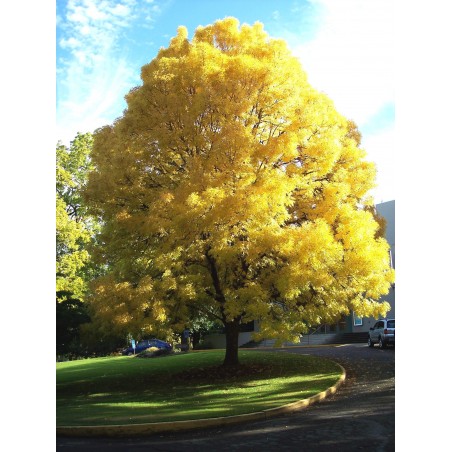
Σπόροι Ευρωπαϊκή Ash
Σπόροι Ευρωπαϊκή Ash
Τιμή για το πακέτο των 20 σπόρων.
Fraxinus excelsior — known as the ash, or European ash or common ash to distinguish it from other types of ash — is a species of Fraxinus native to most of Europe with the exception of northern
Σπόροι Ευρωπαϊκή Ash
Τιμή για το πακέτο των 20 σπόρων.
| Sowing Instructions | |
| Propagation: | Seeds |
| Pretreat: | 0 |
| Stratification: | 0 |
| Sowing Time: | all year round |
| Sowing Depth: | 0.5 - 1 cm |
| Sowing Mix: | Coir or sowing mix + sand or perlite |
| Germination temperature: | about 20-25 ° C. |
| Location: | bright + keep constantly moist not wet |
| Germination Time: | 3-5 weeks |
| Watering: | Water regularly during the growing season |
|
|
|


Η βαθμολόγηση της κριτικής δεν μπορεί να αποσταλεί
Αναφορά σχολίου
Αναφορά αποστάλθηκε
Η αναφορά σου δεν μπορεί να σταλεί
Γράψτε μια κριτική
Κριτική αποστάλθηκε
Η κριτική σου δεν μπορεί να σταλεί
🌍 Παγκόσμια Αποστολή από την Ευρωπαϊκή Ένωση
Αποστέλλουμε παγκοσμίως από την Ευρωπαϊκή Ένωση, μέσω συστημένου ταχυδρομείου με απόδειξη παραλαβής.
📦 Παρακολούθηση Παραγγελιών
Συνδεθείτε στον λογαριασμό σας και πηγαίνετε στο Ιστορικό Παραγγελιών > Λεπτομέρειες για να βρείτε τον αριθμό παρακολούθησης.
Παγκόσμια παρακολούθηση: 17Track
Για αριθμούς όπως RGxxxxxxHR: Παρακολούθηση μέσω Posta.hr
🕒 Παρακαλούμε περιμένετε έως και 24 ώρες μετά την αποστολή ώστε να εμφανιστούν οι πληροφορίες παρακολούθησης.
⚠️ Σημαντικές Πληροφορίες
Η αντικαταβολή δεν υποστηρίζεται.
Ελέγχετε τακτικά το φάκελο ανεπιθύμητης αλληλογραφίας (spam/junk) για ειδοποιήσεις.
Χρησιμοποιείτε πάντα τη φόρμα επικοινωνίας στον ιστότοπο.
Μηνύματα που αποστέλλονται σε e-mail ενδέχεται να μην γίνουν δεκτά.
📱 Στοιχεία Επικοινωνίας
Παρακαλούμε να παρέχετε πάντα τον αριθμό κινητού τηλεφώνου σας με τον διεθνή κωδικό χώρας.
Παράδειγμα: +30 694 123 4567
🚚 Όροι Αποστολής
Οι συστημένες αποστολές απαιτούν υπογραφή του παραλήπτη.
Μην κάνετε παραγγελία αν:
Θέλετε να παραδοθεί σε ταχυδρομική θυρίδα (P.O. Box)
Δεν θα είστε παρόντες για την παραλαβή
Θέλετε να το παραλάβει γείτονας (δεν υποστηρίζεται)
📬 Αν το πακέτο χαθεί λόγω λανθασμένης διεύθυνσης (π.χ. P.O. Box), δεν παρέχεται επιστροφή χρημάτων.
↩️ Επιστροφές & Επαναποστολή
Αν το πακέτο επιστραφεί:
Επιβαρύνεστε με 2 € για επιστροφή
Καθώς και με το κόστος επαναποστολής
⏱ Καθυστέρηση & Παρακολούθηση
Αν η παρακολούθηση δείχνει ότι το πακέτο είναι ακόμα στον αποστολέα, αυτό σημαίνει ότι είναι καθ’ οδόν.
Επικοινωνήστε με το τοπικό ταχυδρομείο χρησιμοποιώντας τον αριθμό παρακολούθησης.
Δεν είμαστε ταχυδρομική υπηρεσία και δεν μπορούμε να παρακολουθήσουμε το πακέτο για εσάς.
Δεν ευθυνόμαστε για τις καθυστερήσεις παράδοσης.
🔍 Έρευνα για καθυστερημένη ή χαμένη αποστολή ξεκινά μετά από 30 ημέρες από την αποστολή.
✈️ Επιλογές Αποστολής
| Επιλογή Αποστολής | Χρόνος Επεξεργασίας | Ασφάλεια | Πιθανές Καθυστερήσεις | Σχόλια |
|---|---|---|---|---|
| Κανονική | 7–10 εργάσιμες ημέρες | ❌ | 7–14 ημέρες | Οικονομική επιλογή |
| Προτεραιότητας | 1–7 εργάσιμες ημέρες | ❌ | 3–10 ημέρες | Προτεραιότητα στην επεξεργασία, όχι ταχύτερη αποστολή |
| Ασφαλισμένη | 1–7 εργάσιμες ημέρες | ✅ | 3–10 ημέρες | Πιο ασφαλής — επιστροφή χρημάτων αν χαθεί το πακέτο (μέχρι 150 €) |
🕒 Εκτιμώμενος χρόνος παράδοσης:
Εντός ΕΕ: 3–20 εργάσιμες ημέρες
Παγκοσμίως: 5–30 εργάσιμες ημέρες
Παραδείγματα για ΗΠΑ: 27, 22, 19, 17, 13 ημέρες
💳 Τρόποι Πληρωμής
💶 Τραπεζική Μεταφορά (SEPA / IBAN / SWIFT-BIC)
Αναφέρετε τον αριθμό παραγγελίας στην περιγραφή πληρωμής (π.χ. SGS-19811702).
Χωρίς αυτόν, η παραγγελία σας μπορεί να καθυστερήσει ή να ακυρωθεί.
Αν η πληρωμή δεν γίνει εντός 7 ημερών, η παραγγελία ακυρώνεται αυτόματα.
🅿️ PayPal
Δεχόμαστε πληρωμές μόνο σε ευρώ (EUR).
Αλλάξτε το νόμισμα σε ευρώ πριν από την πληρωμή.
💳 Πιστωτική/Χρεωστική Κάρτα
Ιστότοπος πληρωμής: Exotic Seeds Store
Δεκτές κάρτες: Visa, MasterCard, American Express, Diners Club, UnionPay, JCB, Discover κ.ά.
💡 Ο πελάτης καλύπτει όλα τα τραπεζικά/μεταφορικά έξοδα.
Αποστείλετε αποδεικτικό πληρωμής για γρηγορότερη επεξεργασία.
📅 Άλλες Πληροφορίες
Δεν στέλνουμε παραγγελίες Σάββατο & Κυριακή.
Ελέγχετε τις σημαντικές ανακοινώσεις στον ιστότοπό μας πριν την παραγγελία (π.χ. αργίες, καθυστερήσεις).
📫 Σημαντικό:
Μην μας στέλνετε email. Χρησιμοποιήστε αποκλειστικά τη φόρμα επικοινωνίας στον ιστότοπο.
Related Products













